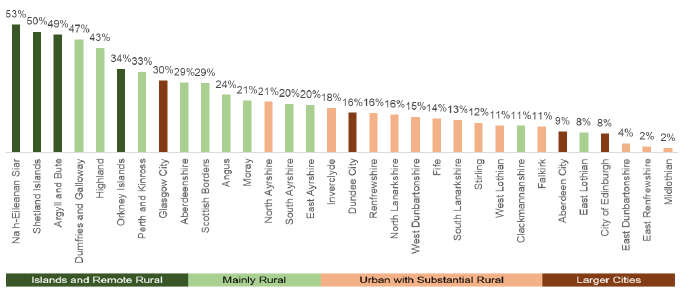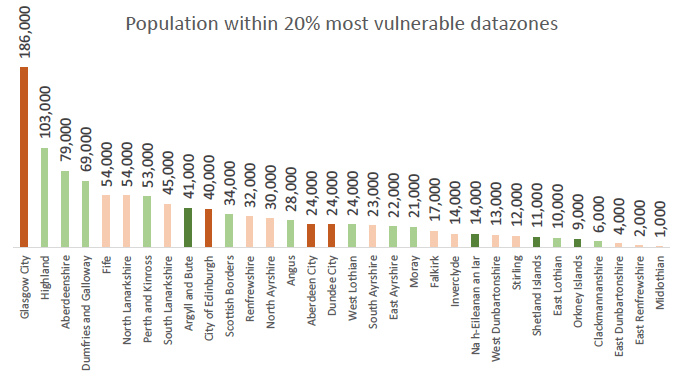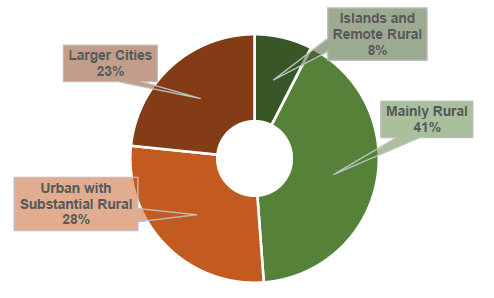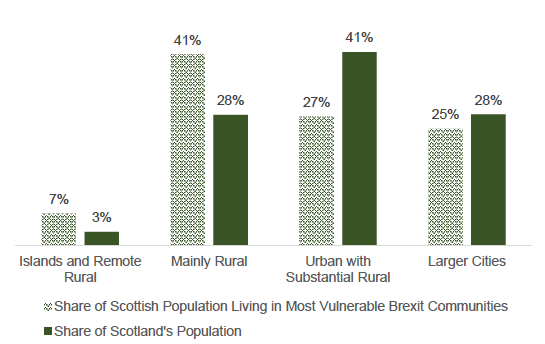Local level Brexit vulnerabilities in Scotland: Brexit Vulnerabilities Index (BVI)
This research identifies areas of Scotland that are expected to be most vulnerable to the consequences of Brexit, and what drives those risks to support local authorities and other organisations in understanding local risks around EU exit.
3. Producing a local Brexit Vulnerability index
As outlined in the previous Chapter, Brexit, and in particular a No Deal Brexit, presents a number of risks to Scotland's communities and businesses. However, Scotland's communities are not homogeneous, and it is important to understand the different implications and transmission mechanisms via which Brexit will impact on different parts of Scotland.
One way in which this can be done is by assessing the extent to which the characteristics of different communities make them more or less vulnerable to the economic implications of Brexit.
The analysis in this paper is derived from a similar methodology used to calculate rankings in the UK indices of multiple deprivation, such as the Scottish Index of Multiple Deprivation (SIMD)[12]. The Brexit Vulnerability Index ranks, in order of risk and vulnerability, each datazone according to the data from indicators.
The indicators have been chosen due to the particular exposure to socio-economic conditions that a community may face but does not assume a particular type of Brexit, nor can it estimate the extent of impact that Brexit may have on different communities in Scotland (it is identifying impact likelihood, not extent). Indicators were weighted using a combination of factors, including overall relevance to Brexit, the quality of the data, and significantly also by using outcomes from the work by the UK Government in the "HMG Reasonable Worst-Case Planning Assumption"[13].
An indexed rank has been produced for each datazone in Scotland. There are nearly 7,000 datazones covering the whole of Scotland and each datazone has a population between 500 to 1,000 people. This allows for a very granular level of analysis.
Eight indicators are used to construct the index, capturing the following factors. Further information on the variables used is summarised in Table 2.
Income Deprivation – Higher levels of deprivation make a community less resilient to large scale socio-economic shocks. Given the likely economic shocks associated with Brexit there is a general risk that these communities will be particularly vulnerable. Additionally, low income households tend to spend the greatest portion of their income on the types of goods that could attract tariffs in some Brexit scenarios (e.g. food).[14] This variable is weighted heavier than other variables. This reflects outcomes acknowledged in the UK Government's Yellowhammer planning assumptions which note that "low income groups will be disproportionately affected by any price rises in food and fuel"[15].
Workers in Brexit-sensitive sectors – The Scottish Government previously commissioned EY to undertake an analysis of the impact that an orderly Brexit could have on different sectors in the Scottish economy. This found that Life Sciences, High Value Manufacturing, Chemicals; Logistics; Food, Drink, including Agriculture and Aquaculture: Creative Industries, including Digital; and Financial and Business Services would be most at risk.[16] Communities with high levels of employment in Brexit-sensitive sectors may therefore be particularly vulnerable. This variable is weighed more heavily to because of the direct relationship between Brexit and workers jobs and employment risks[17].
Access to Services – This is measured as travel time to core public and private services, such as GP Surgeries, shops, Post Offices and is used as a proxy for geographical remoteness. Communities and businesses that face a long travel time from key services, shops and are at the end of supply chains and are likely to see greater impact from disruption to imports and exports. In addition, longer travel times and smaller labour markets mean individual labour market impacts can have disproportionate effects in such locations. This risk is also reflected in the UK Government's Operation Yellowhammer planning around delivering supplying goods and services.[18] Service providers in some rural parts of Scotland already face challenges in recruiting staff and therefore the assumption is that those areas will be disproportionately affected if service providers go out of business.
Working Age Population (as share of total population) – Brexit poses a challenge for communities with a relatively smaller working age population. These areas are more at risk for three reasons. Firstly, if as a result of Brexit migration slows down, the problem of ageing population will become more severe as migrants tend to be in the working-age. Thus, dependency ratios might increase further. Secondly, an ageing population puts further pressure on the provision of public services and spending. Thirdly, labour markets rely on access to workers, which again becomes increasingly difficult in areas with a relatively smaller population in the working age.
Population Change – Communities which face pre-existing demographic challenges, especially depopulation, are likely to experience a proportionately greater impact from lower levels of migration.
European Payments:
a) European Structural Funds and European Social Funds[19] These are direct monies paid by the European Commission to communities, local authorities and businesses across Scotland to deliver economic development or support vulnerable communities. Communities which receive higher levels of European Funding are at greater risk of negative consequences should that European funding be ended or reduced by the UK Government in the future.
b) Common Agricultural Policy (CAP) payments [20] – In the event of disruption or changes to payments post-Brexit, the communities in highest receipt of these payments are likely to see a greater impact. CAP is recorded separately because of different payment mechanisms.
EU Migration – Companies and communities which are particularly reliant on EU migrants will be more vulnerable to economic disruption and any change in free movement of labour post-Brexit.
Table 2 – Description of variables used
| Theme | How is it being measured | Source | Weight[21] |
|---|---|---|---|
| Access to Services | Geographic Access to Services (based on a range of drive time data) | Scottish Index of Multiple Deprivation 2016 https://www2.gov.scot/Topics/Statistics/SIMD | 20 |
| Working Age Population | Share of the population aged 16 – 64 | National Records of Scotland, population statistics https://www.nrscotland.gov.uk/statistics-and-data/statistics/statistics-by-theme/population/population-estimates/mid-year-population-estimates | 20 |
| Income Deprivation | Share of population who are income deprived | Scottish Index of Multiple Deprivation 2016. https://www2.gov.scot/Topics/Statistics/SIMD | 40 |
| Population change | Change in population from 2011-2017 | National Records of Scotland, population statistics (2011-2017). https://www.nrscotland.gov.uk/statistics-and-data/statistics/statistics-by-theme | 20 |
| Workers in Brexit-sensitive industries | Proportion of the workforce in industries identified as being most exposed to Brexit | These figures are based on an analysis undertaken by the Communities Analysis Division within Scottish Government. Data is taken from NOMIS (BRES), and from the Agricultural Census. Sectors were selected that had been identified as most vulnerable to Brexit and referred to in analysis undertaken by EY for the Scottish Government. EY undertook an analysis of the impact that a disorderly Brexit could have on different sectors in the Scottish economy. This found that Life Sciences, High Value Manufacturing, Chemicals; Logistics; Food, Drink, including Agriculture and Aquaculture: Creative Industries, including Digital; and Financial and Business Services would be most at risk.[22] Total vulnerable employment for each datazone (BRES + Agricultural Census) was divided by total employment to calculate percentage employment vulnerable to Brexit. A 30% cut off to define datazones with a higher workforce vulnerability was chosen. | 30 |
| EC Payments | EC CAP payments for 2017 and 2018 | The payments data used are for the combined European Commission (EC) financial years of 2017 and 2018. EC financial years run for 16 October to 15 October. The locations assigned to the payments are based on the registered address of the recipients, which in some cases may not be where the money is spent/used. CAP payments data are available to download here: http://cap-payments.defra.gov.uk/Download.aspx | 10 |
| European Structural Funds – European Social Fund (ESF) and European Regional Development Fund (ERDF). | For the period from 2014 to 2020, Scotland received €476 million from the European Regional Development Fund (ERDF) and €465 million from the European Social Fund (ESF). For this paper, only payments to local authorities are included. Payments to Scottish Government or agencies are excluded as they cannot be attributed to specific areas. | 5 | |
| EU Migration | National Insurance Number registrations by EU nationals | National Insurance Number Adult overseas (NiNo) registrations, Department for Work and Pensions.[23] https://stat-xplore.dwp.gov.uk/webapi/jsf/login.xhtml | 20 |
For every datazone in Scotland, data on each of these indicators was collected, weighted according to data quality, level of importance and commonality, and combined together to produce an overall Brexit Vulnerability Index Score for each community (Annex 2).
The vulnerability ranking is therefore an ordinal measure. This means that the scores represent a ranking of datazones from the least vulnerable to the most vulnerable to Brexit, based on the criteria used. A datazone with a higher score is estimated to have a greater level of vulnerability to Brexit than an area with a lower score. However, the scores do not measure how much more vulnerable an area is. A datazone which has a score of 80, is more vulnerable than one which has a score of 40 but not necessarily twice as vulnerable.
Inevitably, such analysis will never be able to capture the factors unique to any one community in Scotland. Datazones are not standalone areas. They are part of much wider communities where individual risks will interact, overlap and spill over from one datazone to another. For example, if datazone A is found to be comparatively less vulnerable to Brexit on the basis of the above indicators, but the surrounding datazones are all estimated to have a high level of vulnerability this will inevitable have an impact on datazone A. Given the range and subtlety of such interactions, they are impossible to account for in a comprehensive manner in this analysis. As such whilst the broad trends highlighted in the following analysis are clear, care should be taken in seeking to draw specific conclusions about the precise vulnerability of any one datazone.
Further information on the methodology used is provided in Annex 2.
Most Vulnerable Communities in Urban and Rural Scotland
The results show that the areas that are most vulnerable to Brexit (those in the top 20% of vulnerable datazones in Scotland) are distributed throughout the country. However, there is a higher concentration of such datazones in remote and rural locations.
Urban areas have proportionately fewer datazones in the most vulnerable 20% across Scotland, though Glasgow has more vulnerable people than any other local authority in absolute terms. Vulnerabilities in urban areas tend to be caused by low incomes. However, overall urban areas tend to have comparatively stronger demographics, more diversified economies and a better balance of working age population. They also tend to have comparatively low receipts of European CAP funding, but do receive significant amounts of European Social and Structural Funds. Likewise, most local authorities in this classification are located in the central belt, thus have relatively better access to services, higher incomes and positive demographics. Therefore, whilst urban areas are still at risk from the impacts of leaving the EU, these risks are proportionately lower, on average, than those faced by rural areas.
In rural areas there are higher likelihoods of vulnerabilities. Geographical remoteness in itself is likely to increase an area's vulnerability as communities at the end of supply chains are likely to see greater impact from disruption to imports and exports. In addition, longer travel times and smaller labour markets mean individual labour market impacts can have disproportionate effects in such locations. This is compounded by the wider Brexit vulnerabilities that rural locations typically face. For example, CAP funding, tends to be concentrated in rural communities, so future risks to funding are highest in those communities. Depopulation is also more common in rural communities, and as larger urban areas tend to have more diversified economies, and concentrations of workers in Brexit sensitive sectors are less common.
Most Vulnerable Communities within each local authority
The following analysis looks in more detail at the 20% of communities in Scotland identified as being most vulnerable to Brexit.
The chart below summarises the concentration of these datazones across each local authority. It shows 53% of communities in Na h-Eileanan Siar at datazone level are within the 20% most vulnerable communities in Scotland; in the Shetland Islands it is 50%, and 49% of those in Argyll and Bute. This reflects the high concentration of the workforce in Brexit vulnerable sectors such as fishing and agriculture; relatively high European CAP funding receipts and poorer access to services, though there is variation within these areas.
The areas that have the lowest concentrations of Brexit vulnerabilities are Edinburgh, East Dunbartonshire, East Renfrewshire, and Midlothian. These local authorities share several characteristics: all are located on or near the central belt and have relatively diversified economies. All have had significant population growth over the past decade which helps shelter them against depopulation vulnerabilities and have relatively low levels of deprivation. As noted, such locations are not immune from the risks of Brexit, and they all face clear risks, and have areas which are in the most vulnerable 20%. However, these risks are relatively lower than for more deprived urban or more rural locations.
Figure 4 Shares of most Brexit vulnerable datazones by local authority

Figure 4 shows the proportion of datazones which are in the nationally most vulnerable 20% for each local authority. The bars are coloured according to the RESAS classification of the rural economy for local authorities. Broad differences between rural and urban areas are clear:
- Rural local authorities tend to have the greatest shares of communities which are included in the 20% most vulnerable
- Urban areas tend to have the smallest shares of communities which are included in the 20% most vulnerable
- Figure 4 shows that the areas that have the lowest concentrations of Brexit vulnerabilities are Midlothian, Edinburgh, East Dunbartonshire and East Renfrewshire. These local authorities share several characteristics: all are located on or near the central belt and have relatively diversified economies. All have had significant population growth over the past decade which helps shelter them against depopulation vulnerabilities and have relatively low levels of deprivation.
Figure 4 however does not reflect the number of people living in most vulnerable areas. Figure 5 below, shows the distribution of the population living in the 20% most vulnerable Scottish datazones by local authority and thus directly links with Figure 4. Figure 5 highlights that whilst urban local authorities have a lower share of the most vulnerable datazones, the population living in these areas is larger. For example, 186,000 people in Glasgow live within the most vulnerable datazones in Scotland, more than any other local authority. Likewise, nearly 170,000 people in Fife, North and South Lanarkshire and Edinburgh combined are living within the most vulnerable datazones in Scotland.
Figure 5 Shares of population in most Brexit vulnerable datazones by local authority

Figure 6 below shows where the 20% most vulnerable communities are located within Scotland, using the LA urban-rural classification. This means we can see the overall share between urban and rural of the most vulnerable communities.
Figure 6 Share of the 20% most vulnerable communities by type of community

This analysis shows that Mainly Rural communities account for two fifths (41%) of the most vulnerable 20% datazones. More than a quarter of the most vulnerable communities are located in Urban with Substantial Rural communities, 23% in Larger Cities and only 8% in Islands and Remote Rural communities. So overall, whilst vulnerability is more common in rural areas, because of the population differences, more datazones (and therefore more people) live in urban or suburban areas at risk of Brexit. This is explored in Figure 7 below which shows the distribution of people living in the most Brexit-vulnerable communities compared with their overall shares of the population
Figure 7 Distribution of Populations in Most Vulnerable Communities

Figure 7 above illustrates the size of the population within each classification overall and the share of those people living in the 20% most vulnerable datazones. The figure shows that whilst the population in Islands and Remote Rural local authorities only accounts for 3%, and in Mainly Rural only for 28% of the Scottish overall population, the share of the population living in vulnerable datazones is substantially higher with 7% in Islands and Remote and 41% in Mainly Rural. In Urban with Substantial Rural local authorities and in Larger Cities, the population is relatively less at risk. Nevertheless, around a quarter in each of the more urban areas live in the most vulnerable datazones.
Contact
Email: ruralstatistics@gov.scot
There is a problem
Thanks for your feedback